Tankless Toilets – How They Work and More!
Last Updated on July 27, 2023 by toilethaven
In order to flush a toilet, a large volume of water must be dumped inside the bowl at once. Since most homes’ water supply does not have sufficient pressure to do that, a toilet tank, therefore, becomes a necessity.
You might, however, notice that toilets in public restrooms, and especially urinals, do not have a tank. Modern residential toilets do not also have a tank. So, how does a tankless toilet work?
Tankless toilets do not have a water tank on top of the bowl and instead use water under high pressure straight from the supply line to flush the toilet. In buildings with insufficient water pressure, tankless toilets are installed with a small water pump.
Although tankless toilets are mostly used in public restrooms, you can also install a tankless toilet in your home. Residential tankless toilets are, in most cases, smart toilets as well, where they combine they combine their tankless design with other features like bidet seats and auto-opening/closing seats.
How Does a Tankless Toilet Work?
Unlike gravity flush toilets which depend on water from a tank, tankless toilets use pressurized water to flush a toilet; hence they need a pump. As a result, tankless toilets have a powerful flush and hardly ever clog.
The advantages of tankless toilets are that they are space-efficient and that, unlike a gravity flush toilet, you don need to wait for them to refill, making them effective for busy establishments. They are also not likely to clog.
Tankless toilets are more expensive than ordinary tank toilets, especially residential tankless toilets, which also tend to be smart toilets. They are also dependent on electricity which is not cheap and is therefore not used if there is a power blackout.
Tankless toilets are calibrated to release a metered amount of water during each flush. They are usually more water-efficient than gravity-flush toilets.
Residential tankless toilets are also known as smart toilets or bidet toilet combos. Apart from being tankless, they come with a bidet toilet seat and are so sleek and stylish. Read more here.
Tankless Toilets Vs. Tank Toilets
To properly understand how a tankless toilet works, let us first look at how a tank toilet works and the reason why a toilet tank is important.
Tank toilets are also known as gravity flush toilets. This is because the toilet tank is installed n top of the tank, and thus the water flows from the tank to the bowl using gravity during flushing. Unlike tankless toilets, tank toilets do not need electricity to run.
The toilet tank is connected to the main water supply by a water supply line at the shut-off valve. This makes sure that the tank is always full of water and ready to use.
Tank toilets use different amounts of water to flush the toilet. Old models can use up to 3.5 gallons per flush, while newer models use 1.6 or 1.28 gallons per flush.
To flush a tank toilet, you pull a trip level located on the side of the front of the tank. Dual flush toilets use buttons mounted at the top of the tank.
During flushing, water leaves the tank through an opening at the bottom called a flush valve to enter the bowl. The flush valve is afterward sealed off by the toilet flapper allowing the tank to refill.
Tankless toilets are flushed using a device called a flushometer. A metered volume of water sufficient to flush the toilet is released every time you push the flushometer.
Residential smart tankless toilets have automatic flushing systems, while some use a wireless remote control. Some also combine the 2 functions.
Due to the lack of a toilet tank, tankless toilets have few leaks (if any a toilet) and hence fewer repairs than tank toilets. They are also more compact, making them ideal for small bathrooms.
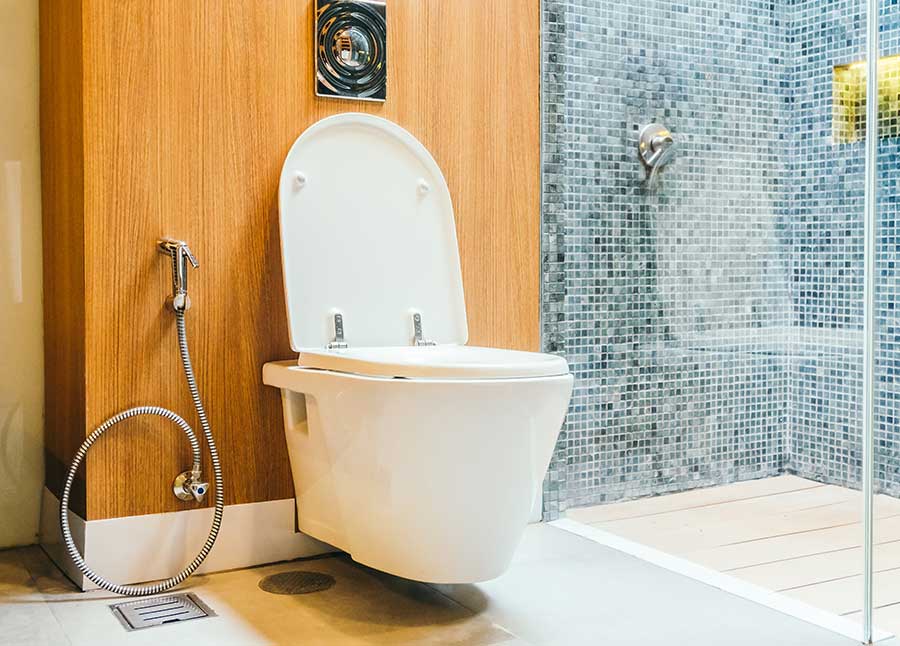
Tankless Toilets Vs. Pressure-Assisted Toilets
Tankless toilets should not be compared with pressure-assisted toilets. Although some have a pressure-assisted flushing system, they are not what are known as pressure-assisted toilets.
Pressure-assisted toilets are tank toilets that look exactly like gravity flush toilets but do not 100% rely on gravity to help them flush. They have a secondary tank inside the main toilet tank called a pressure vessel.
Water from the supply line enters this pressure vessel, where the air is trapped and compressed. The water is therefore stored inside the tank under pressure.
When you flush the toilet, pressurized water is dumped inside the bowl forcefully, and the process starts once again in the pressure vessel. As a result, pressure-assisted toilets are louder than ordinary gravity-flush toilets.
Pressure-assisted toilets are especially helpful for people looking to install read-discharge toilets. In rear discharge toilets, waste exits the toilet from the back instead of the floor.
Rear discharge, also known as rear outlet toilets, have a shorter toilet trap, which is insufficient to initiate a strong enough siphon action. Pressure-assisted toilet system comes in to give them the extra oomph.
Read more on pressure-assisted toilets here.
Tankless Toilets Vs. Wall-Hung Toilets
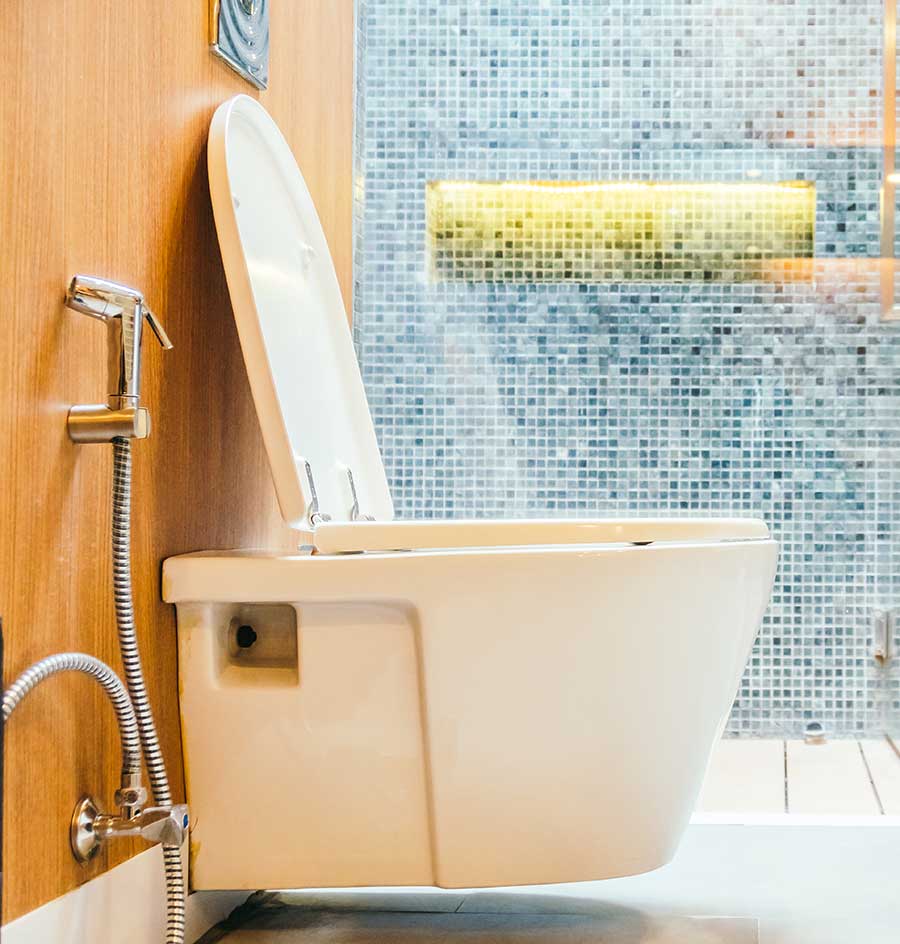
Another type of toilet that should not be confused with tankless toilets is wall-hung toilets, also known as wall-mounted toilets. They look more like they are tankless, but they have a tank.
Wall-hung toilets are mounted on the bathroom wall, unlike other floor-mounted toilets. Their toilet tanks are concealed in the bathroom wall, so only the bowl is visible.
To install a wall-hung toilet, a frame called a carrier is installed on the bathroom wall. The carrier is used to “carry” the toilet tank, where the bowl is mounted using long bolts.
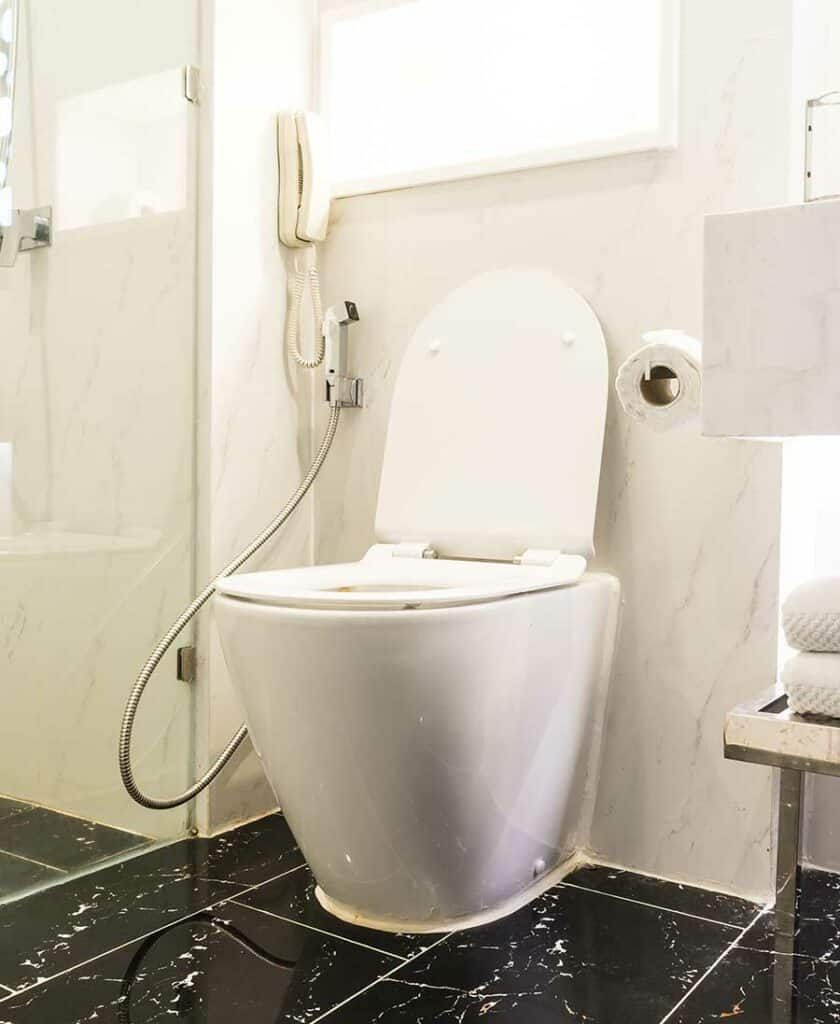
To conceal the toilet tank and the carrier, a secondary wall is erected inside the bathroom, leaving only a small opening where the flush buttons are mounted. This opening also gives you access to the toilet tank in case you need to carry out any repairs.
Unlike wall-hung toilets, tankless toilets are floor mounted and do not need a tank carrier or the erection of a secondary bathroom wall.
Read more on wall-hung toilets here.
Pros and Cons of Tankless Toilets
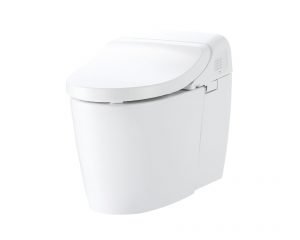
The Pros
- Space-efficient
- Fast flushing system
- Sleek design
- Environment-friendly
- Few problems
- Easy to clean
- Powerful flush
The Cons
- Dependent on electricity
- Hard to repair
- They are expensive
- Noisy flushing
Benefits of a Tankless Toilet
The following are the pros/benefits/advantages of installing a tankless toilet over a tank toilet.
Space Efficiency
It is possible to install a tankless toilet in a small bathroom without it looking stuffy. If anything, a tankless toilet will make a small bathroom look big. You can use up the extra space to spruce up your bathroom, which will improve its overall décor.
One thing to remember is that tank toilets are wider than tankless toilets because of the tank, which also makes them longer. The absence of the tank also makes tankless toilets way shorter than tank toilets.
People with small bathrooms will find tankless toilets to be a great option.
Fast Flushing
In a tank toilet, after every flush, you have to wait for the tank to refill before you can flush again. It is even worse if the waste is not cleared in the first round, and you have to wait for the tank to refill before attempting again.
Tankless toilets do not need to refill. They are always ready to use. This makes tankless toilets the best choice for a bathroom with many users.
Sleek Design
Although it is not impossible to find sleek tank toilets, tankless toilets definitely pay the price. They are elegant, stylish, and modern and will, without a doubt, complement any bathroom design.
As I had said before, residential tankless toilets use bidet seats which, just like the toilets, are beautifully designed. Bidet seats are more solid than regular toilet seats and fit the toilet perfectly, further enhancing its beauty.
Eco-Friendly
Tank toilet owners will, from time to time, have to deal with a constantly running toilet, leaking toilet, overflowing toilet, low levels of water in the tank and bowl, and other issues from time to time. All these problems emanate from the toilet tank.
When you have a tankless toilet, the above problems will be unheard of. Every amount of water that enters the bowl is metered and hence precise, without the possibility of leaking.
A leaking/running toilet is not only bad for the environment but also for your pocket.
Fewer Problems
A toilet tank has very many parts inside which fail/wear out after some time, necessitating replacements. Seeing that tankless toilets have fewer parts. They tend to have fewer problems to fix.
Few problems mean few repairs. A tankless toilet has few moving parts therefore wear and tear is not something owners have to deal with.
Once you install a tankless, it will serve you for a long time before you are required to do any maintenance.
Easy to Clean
The tankless toilet has few nooks and crannies compared to a tank toilet. Cleaning and maintaining the general hygiene of the toilet is, therefore, very easy and fast.
Their bowls are mostly fully skirted, meaning dirt has nowhere to hide. This is not always the case with tank toilets. The gap between the tank and the bowl in two-piece toilets, for instance, is tough to reach during cleaning.
Powerful Flush
While using a tank toilet, you are unsure if the first flush will do the job. You must wait for confirmation.
The mess is taken care of with a tankless toilet in the first round. The water pressure is enough to push all the waste through the trap and down the drainpipe.
Tankless Toilets Problems
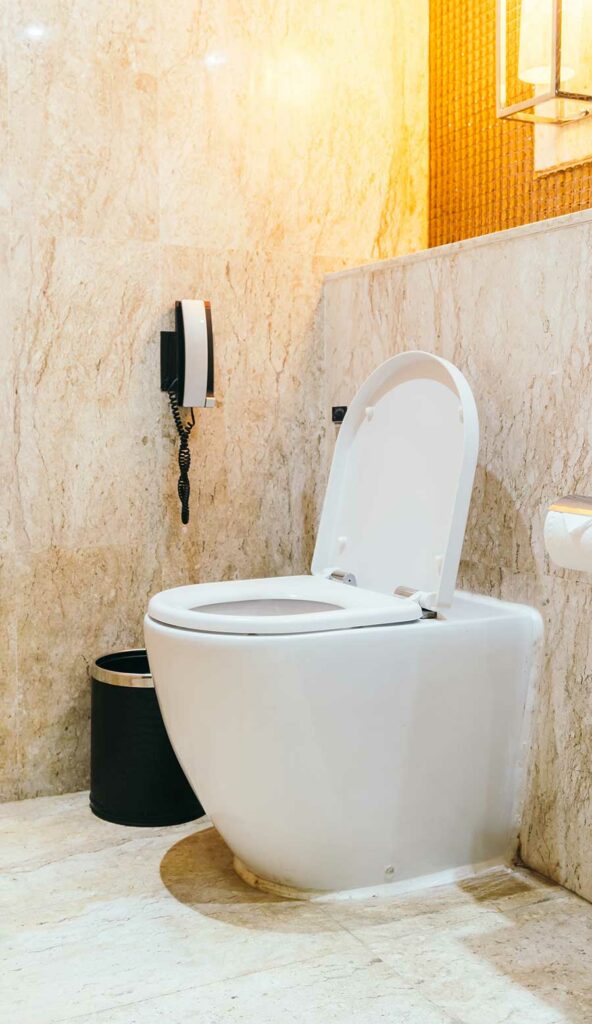
So, what are the disadvantages of installing tankless toilets? Here are some of them:
Dependent on Electricity
Tankless toilets need a connection to an electrical outlet to power the water pump. Without electricity, you can only flush the toilet with a bucket of water.
If you live in an area prone to power outages, the joy of owning a tankless toilet will be short-lived. You may be required to have a standby generator, which is not always cheap.
You will also start more in power bills after installing a tankless toilet. Apart from the power required to run the power, the bidet seat will also need to be connected to power to run its functions like hot water cleansing, warm air drying, heated seat, nightlight, etc.
Hard to Repair
It is straightforward to fix a gravity-flush toilet. The same cannot be said of tankless toilets. You will need to bring in a professional plumber to help with any issues that may arise.
Their replacement parts are also not readily available compared to a tank toilet’s parts and tend to be more pricey.
They are Expensive
Tankless toilets cost way more than gravity flush toilets. This is not surprising when considering all their features relative to those of gravity-flush toilets.
For comparison purposes, consider the Toto Ultramax II, one of the best gravity-flush toilets. Now compare it with the Toto Neorest 750H tankless toilet. The cost of the Toto Neorest 750H is more than 10 times that of the Ultramax II.
There are, however, cheaper tankless toilets, especially those without bidet functions.
They are Noisy
The flush water in a tankless toilet gashes out and cleans the toilet forcefully. As a result, they tend to be very noisy. This has to be considered before they are installed.
The noise will concern you for the first few days, but an after a while, you will get used to it.
Tankless Toilets For Small Bathrooms
Do you have a small bathroom where you need to install a tankless toilet? One of the best tankless toilets for a small bathroom is the Saniflo 023 Sanicompact self-contained toilet.
Its dimensions are:
- Depth: 21.5 inches
- Width: 14.5 inches
- Height: 18.5 inches
This toilet can be installed in a basement and a bathroom far from the sewer line. Apart from being a tankless toilet, it is both an up-flush and a rear outlet toilet.
It can install up to 9 feet below a sewer line or up to 120 feet away from a sewer line. You can add a sink and link its gray water to the toilet output system.
This toilet is even better because you don’t need a floor drainage system. It makes it very easy to add a bathroom just about anywhere.
To compare this toilet with other great tankless toilets, check out this post I wrote some time back.
Conclusion
Tankless toilets have been more popular with public toilets than in homes. Technological advancements have seen these toilets start to become a favorite for most people because of the convenience and comfort associated with them.
If you can afford to buy one, then, by all means, go for it. These are the future toilets.